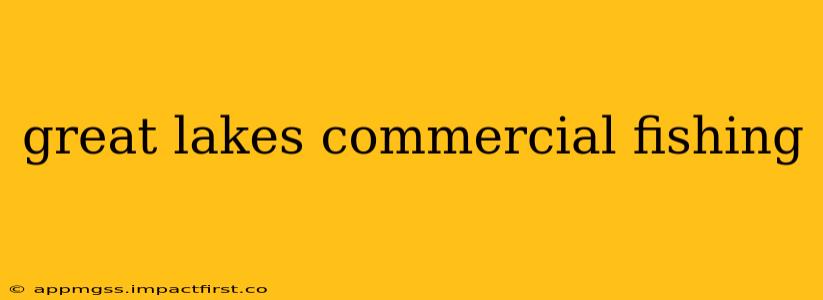The Great Lakes, the largest group of freshwater lakes in the world, support a significant commercial fishing industry. While its scale may not match ocean fisheries, the economic and ecological impact of Great Lakes commercial fishing is substantial and deserves attention. This in-depth look explores the industry's current state, challenges, and future prospects.
What are the main species of fish commercially fished in the Great Lakes?
The Great Lakes support a diverse fish population, but the commercially important species are relatively few. The most prominent include:
- Alewife: A small, oily fish, alewives are a crucial forage fish for many larger predators. While not directly targeted for human consumption in large quantities, they're important for the bait industry and are processed into fishmeal and oil.
- Chub Mackerel: Another forage fish, chub mackerel are also processed into fishmeal and oil.
- Yellow Perch: A popular panfish, yellow perch are highly sought after for their flavor and are a significant part of the commercial catch.
- Whitefish (Lake Whitefish and Cisco): These cold-water species are prized for their delicate flavor and are often sold fresh or frozen. They are a cornerstone of the Great Lakes fishery.
- Rainbow Trout (and other Trout species): While some trout fisheries are managed for recreational purposes, commercial fishing for trout does occur in certain areas and seasons.
What are the biggest challenges facing the Great Lakes commercial fishing industry?
The Great Lakes commercial fishing industry faces a multitude of complex challenges:
- Invasive Species: The introduction of invasive species like sea lampreys, zebra mussels, and quagga mussels has dramatically altered the lake ecosystems, impacting native fish populations and fishing practices. These invaders compete with native species for resources and can even directly harm them.
- Water Quality: Pollution from agricultural runoff, industrial discharge, and urban stormwater significantly affects water quality. This can lead to decreased oxygen levels, harmful algal blooms, and fish kills, impacting fish populations and the health of the ecosystem.
- Climate Change: Changes in water temperature, ice cover, and precipitation patterns due to climate change are altering fish habitats and distribution, posing significant challenges to the industry's sustainability.
- Regulations and Quotas: Strict regulations and catch quotas are necessary for managing fish stocks and ensuring the long-term health of the fisheries. While crucial for conservation, these can limit fishing opportunities and profitability for commercial operations.
- Fluctuating Markets: Market prices for fish can be unpredictable, creating economic uncertainty for commercial fishermen.
What are the economic benefits of the Great Lakes commercial fishing industry?
While often overlooked, the Great Lakes commercial fishing industry provides substantial economic benefits:
- Job Creation: The industry provides jobs directly to fishermen, processing plant workers, and those involved in transportation and distribution.
- Local Economies: Commercial fishing supports local economies in coastal communities, providing income and employment opportunities.
- Food Source: The industry contributes to the regional food supply, providing fresh and healthy seafood.
How is the Great Lakes commercial fishing industry regulated?
The Great Lakes commercial fishing industry is subject to extensive regulation at both the state and federal levels. Agencies like the Great Lakes Fishery Commission and individual state agencies work to:
- Set Catch Limits: Quotas are set to prevent overfishing and protect fish stocks.
- Enforce Fishing Regulations: Regulations on fishing gear, seasons, and size limits are carefully enforced to ensure sustainable practices.
- Monitor Fish Populations: Regular stock assessments are conducted to track fish populations and inform management decisions.
What is the future of Great Lakes commercial fishing?
The future of the Great Lakes commercial fishing industry depends on addressing the challenges it faces. Sustainable practices, innovative management strategies, and collaborative efforts among stakeholders are crucial for ensuring the long-term health and viability of this important industry. Research into climate change adaptation, invasive species control, and improving water quality will be essential for future success. The industry's future hinges on its ability to balance economic needs with ecological sustainability, ensuring that this vital part of the Great Lakes ecosystem thrives for generations to come.
